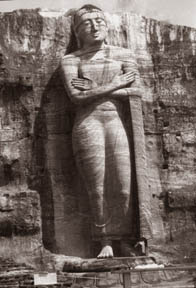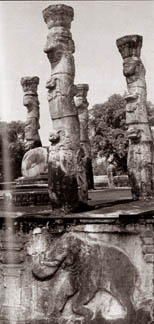|
observer |
|
|
|
|
|
OTHER LINKS |

|

|

|
|
Polonnaruwa: The medieval capital
Polonnaruwa was populated as early as the sixth century BC with settlers who had an agrarian culture. Brahmi letters dated from two centuries before the dawn of the Christian era have been found in the surroundings of Polonnaruwa. Tanks and waterways, some of which to this day are in use, were constructed to cater to the public need, like the picturesque Minneriya tank built in the fourth century by king Mahasena. In fact, Polonnaruwa was initially not so much a well-recognized centre of royal administration, but a place with a prosperous agricultural and irrigational base, which invariably attracted new settlers. The royalty based in the then capital city of Anuradhapura viewed Polonnaruwa as a safe haven of retreat from the constant invasions originating from South India. When Anuradhapura fell to the Chola empire of South India in 993 AD, the Cholas established Polonnaruwa as their capital in 1017 AD. Unpalatable though an invasion may be, this resulted in the rich blend of architecture witnessed today in Polonnaruwa. The Cholas built many Siva and Vishnu temples based on contemporary South Indian Chola architecture. The Chola rule lasted for nearly 70 years until king Vijayabahu I became victorious as the sole ruler of the island in 1070 AD. However, he did not wish to shift the capital back to Anuradhapura and continued to rule from Polonnaruwa.
The Polonnaruwa museum, easily the best archaeological museum in the country today, displays the ancient Panakaduwa copper plate inscription, which details the fascinating story about the young days of king Vijayabahu I, when he organised his war campaign against the Cholas. Marital alliances helped Polonnaruwa keep a close relationship with South Indian royalty. Hence the religious blend continued. Vijayabahu's Chief Queen Lilavathie was the daughter of a king who originally came from Ayodya of India and was ruling some southern parts of the island. The second queen was from Kalinga, India. His youngest sister was married to a Pandya prince. Accession of Parakramabahu the Great (1153-1186 AD) to the throne paved the way for a new era. Thirty three years of his glorious reign is marked as one of the greatest periods of architectural activity in the island. Parakrama Samudra, a giant confluence of two tanks occupying an area of nine square mile symbolizes his dedication to irrigational development. After Parakramabahu, a majority of kings who reigned in Polonnaruwa were of Kalinga origin. A Kalinga prince, Nissankamalla ascended the throne in Polonnaruwa in 1187 AD and ruled till 1196 AD. He was the most successful king to rule after Parakramabahu. The invasion by Magha hailing from Kalinga and his rule preceded the fall of Polonnaruwa as the capital city and its final abandonment. Courtesy Explore SL |













